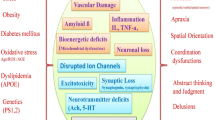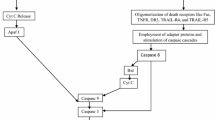Abstract
The mechanisms underlying the selective neuronal death in Alzheimer's disease are largely unresolved. Nonetheless, it is apparent that the environment of the diseased brain is extremely rich in proapoptotic stimuli and that these lead to an activation of the apoptotic death cascade. However, there is surprisingly little evidence for the completion of the death pathway indicating that the apoptotic death program is terminated by a mechanism termed abortosis. This review discusses the concept of abortosis in relation to Alzheimer's disease.
Similar content being viewed by others
References
Salvesen, G. S. and Dixit, V. M. (1999) Caspase activation: the induced-proximity model. Proc. Natl. Acad. Sci. USA 96, 10964–10967.
LeBlanc, A. C. (2003) Natural cellular inhibitors of caspases. Prog. Neuropsychopharmacol. Biol. Psychiatry 27, 215–229.
Bancher, C., Lassmann, H., Breitschopf, H., and Jellinger, K. A. (1997) Mechanisms of cell death in Alzheimer's disease. J. Neural Transm. Suppl. 50, 141–152.
Jellinger, K. A. and Bancher, C. (1998) Neuropathology of Alzheimer's disease: a critical update. J. Neural. Transm. Suppl. 54, 77–95.
Slater, A. F., Stefan, C., Nobel, I., van den Dobbelsteen, D. J., and Orrenius, S. (1995) Signalling mechanisms and oxidative stress in apoptosis. Toxicol. Lett. 82–83, 149–153.
Yankner, B. (1996) New clues to Alzheimer's disease: unraveling the roles of amyloid and tau. Nat. Med. 2, 850–852.
Vander Heiden, M. G., Chandel, N. S., Li, X. X., Schumacker, P. T., Colombini, M., and Thompson, C. B., (2000). Outer mitochondrial membrane permeability can regulate coupled respiration and cell survival. Proc. Natl. Acad. Sci. USA 97, 4666–4671.
Mark, R. J., Lovell, M. A., Markesbery, W. R., Uchida, K., and Mattson, M. P. (1997). A role for 4-hydroxynonenal, an aldehydic product of lipid peroxidation, in disruption of ion homeostasis and neuronal death induced by amyloid beta-peptide. J. Neurochem. 68, 255–264.
Sayre, L. M., Zelasko, D. A., Harris, P. L. R., Perry, G., Salomon, R. G., and Smith, M. A. (1997) 4-Hydroxynonenal-derived advanced lipid peroxidation end products are increased in Alzheimer's disease. J. Neurochem. 68, 2092–2097.
Deng, G., Pike, C. J., and Cotman, C. W. (1996) Alzheimer-associated presenilin-2 confers increased sensitivity to apoptosis in PC12 cells. FEBS Lett. 397, 50–54.
Anderson, A. J., Su, J. H., and Cotman, C. W. (1996). DNA damage and apoptosis in Alzheimer's disease: colocalization with c-Jun immunoreactivity, relationship to brain area, and effect of postmortem delay. J. Neurosci. 16, 1710–1719.
Cotman, C. W. and Su, J. H. (1996) Mechanisms of neuronal death in Alzheimer's disease. Brain Pathol. 6, 493–506.
Tsang, S. Y., Tam S. C., Bremner, I., and Burkitt, M. J. (1996) Research communication copper-1,10-phenanthroline induces internucleosomal DNA fragmentation in HepG2 cells, resulting from direct oxidation by the hydroxyl radical. Biochem. J. 317, 13–16.
Su, J. H., Deng, G., and Cotman, C. W. (1997) Neuronal DNA damage precedes tangle formation and is associated with up-regulation of nitrotyrosine in Alzheimer's disease brain. Brain Res. 774, 193–199.
Smith, M. A., Harris, P. L. R., Sayre, L. M., Beckman, J. S., and Perry, G. (1997) Widespread peroxynitrite-mediated damage in Alzheimer's disease. J. Neurosci. 17, 2653–2657.
Stadelmann, C., Bruck, W., Bancher, C., Jellinger, K., and Lassmann, H. J. (1998) Alzheimer disease: DNA fragmentation indicates increased neuronal vulnerability, but not apoptosis. J. Neuropathol. Exp. Neurol. 57, 456–464.
Perry, G., Nunomura, A., Lucassen, P., Lassmann, H., and Smith, M. A. (1998) Apoptosis and Alzheimer's disease (Letter). Science 282, 1268–1269.
Perry, G., Nunomura, A., and Smith, M. A. (1998) A suicide note from Alzheimer disease neurons? (News and Views). Nat. Med. 4, 897–898.
Jellinger, K. A. and Stadelmann, C. (2001) Problems of cell death in neurodegeneration and Alzheimer's Disease. J. Alzheimer's Disease 3, 31–40.
Jellinger, K. A. (2001) Cell death mechanisms in neurodegeneration. J. Cell. Mol. Med. 5, 1–17.
Raina, A. K., Zhu, X., Rottkamp, C. A., Monteiro, M., Takeda, A., and Smith, M. A. (2000) Cyclin' toward dementia: cell cycle abnormalities and abortive oncogenesis in Alzheimer disease. J. Neurosci. Res. 61, 128–133.
Raina, A. K., Hochman, A., Zhu, X., Rottkamp, C. A., Nunomura, A., Siedlak, S. L., Boux, H., Castellani, R. J., Perry, G., and Smith, M. A. (2001) Abortive apoptosis in Alzheimer's disease. Acta Neuropathol. 101, 305–310.
Stennicke, H. R., Jurgensmeier, J. M., Shin, H., Deveraux, Q., Wolf, B. B., Yang, X., Zhou, Q., Ellerby, H. M., Ellerby, L. M., Bredesen, D., Green, D. R., Reed, J. C., Froelich, C. J., and Salvesen, G. S. (1998) Pro-caspase-3 is a major physiologic target of caspase-8. J. Biol. Chem. 273, 27084–27090.
Cohen, G. M. (1997) Caspases: the executioners of apoptosis. Biochem. J. 326, 1–16.
Trucco, C., Oliver, F. J., de Murcia, G., and Menissier-de Murcia, J. (1998) DNA repair defect in poly(ADP-ribose) polymerase-deficient cell lines. Nucleic Acids Res. 26, 2644–2649.
Roth, K. A., Kuan, C.-Y., Haydar, T. F., D'Sa-Eipper, C., Shindler, K. S., Zheng, T. S., Kuida, K., Flavell, R. A., and Rakic, P. (2000) Epistatic and independent functions of caspase-3 and Bcl-XL in developmental programmed cell death. Proc. Natl. Acad. Sci. USA 97, 466–471.
Selznick, L. A., Holtzman, D. M., Han, B. H., Gokden, M., Srinivasan, A. N., Johnson, E. M. Jr., and Roth, K. A. (1999) In situ immunodetection of neuronal caspase-3 activation in Alzheimer disease. J. Neuropathol. Exp. Neurol. 58, 1020–1026.
Stadelmann, C., Deckwerth, T. L., Srinivasan, A., Bancher, C., Brück, W., Jellinger, K., and Lassmann, H. (1999) Activation of caspase-3 in single neurons and autophagic granules of granulovacuolar degeneration in Alzheimer's disease. Am. J. Pathol. 155, 1459–1466.
Pike, C. J. (1999) Estrogen modulates neuronal Bcl-xL expression and beta-amyloid-induced apoptosis: relevance to Alzheimer's disease. J. Neurochem. 72, 1552–1563.
Srinivasula, S. M., Hegde, R., Saleh, A. Datta, P., Shiozaki, E., Chai, J., Lee, R.-A., Robbins, P. D., Fernandes-Alnemri, T., Shi, Y., and Alnemri, E. S. (2001) A conserved XIAP-interaction motif in caspase-9 and Smac-DIABLO regulated caspase activity and apoptosis. Nature 401, 112–116.
Torp, R., Su, J. H., Deng, G., and Cotman, C. W. (1998) GADD45 is induced in Alzheimer's disease, and protects against apoptosis in vitro. Neurobiol. Dis. 5, 245–252.
Martins, L. M., Kottke, T. J., Kaufmann, S. H., and Earnshaw, W. C. (1998) Phosphorylated forms of activated caspases are present in cytosol from HL-60 cells during etoposide-induced apoptosis. Blood 92, 3042–3049.
Smith, M. A., Perry, G., Richey, P. L., Sayre, L. M., Anderson, V. E., Beal, M. F., and Kowall, N. (1996) Oxidative damage in Alzheimer's. Nature 382, 120–121.
Hampton, M. B., Fadeel, B., and Orrenius, S. (1998) Redox regulation of the caspases during apoptosis. Ann. NY Acad. Sci. 854, 328–335.
Allen, J. W., Eldadah, B. A., Huang, X., Knoblach, S. M., and Faden, A. I. (2001) Multiple caspases are involved in beta-amyloid-induced neuronal apoptosis. J. Neurosci. Res. 65, 45–53.
Nakagawa, T., Zhu, H., Morishima, N., Li, E., Xu, J., Yankner, B. A., and Yuan, J. (2000) Caspase-12 mediates endoplasmic-reticulumspecific apoptosis and cytotoxicity by amyloidbeta. Nature 403, 98–103.
LeBlanc, A., Liu, H., Goodyer, C., Bergeron, C., and Hammond, J. (1999) Caspase-6 role in apoptosis of human neurons, amyloidogenesis, and Alzheimer's disease. J. Biol. Chem. 274, 23426–23436.
Lassmann, H., Bancher, C., Breitschopf, H., Wegiel, J., Bobinski, M., Jellinger, K., and Wisniewski, H. M. (1995) Cell death in Alzheimer's disease evaluated by DNA fragmentation in situ. Acta Neuropathol. 89, 35–41.
Lucassen, P. J., Chung, W. C., Vermeulen, J. P., Van Lookeren Campagne, M., Van Dierendonck J. H., and Swaab, D. F. (1995) Microwave-enhanced in situ end-labeling of fragmented DNA: parametric studies in relation to postmortem delay and fixation of rat and human brian. J. Histochem. Cytochem. 43, 1163–1171.
Lucassen, P. J., Chung, W. C., Kamphorst, W., and Swaab, D. F. (1997) DNA damage distribution in the human brain as shown by in situ end labeling; area-specific differences in aging and Alzheimer disease in the absence of apoptotic morphology. J. Neuropathol. Exp. Neurol. 56, 887–900.
Sheng, J. G., Mrak, R. E., and Griffin, W. S. (1998) Progressive neuronal DNA damage associated with neurofibrillary tangle formation in Alzheimer disease. J. Neuropathol. Exp. Neurol. 57, 323–328.
Sheng, J. G., Zhou, X. Q., Mrak, R. E., and Griffin, W. S. (1998) Progressive neuronal injury associated with amyloid plaque formation in Alzheimer disease. J. Neuropathol. Exp. Neurol. 57, 714–717.
Sperandio, S., de Belle, I., and Bredesen, D. E. (2000) An alternative, nonapoptotic form of programmed cell death. Proc. Natl. Acad. Sci. USA 97, 14376–14381.
Author information
Authors and Affiliations
Corresponding author
Rights and permissions
About this article
Cite this article
Raina, A.K., Zhu, X., Shimohama, S. et al. Tipping the apoptotic balance in Alzheimer's disease. Cell Biochem Biophys 39, 249–255 (2003). https://doi.org/10.1385/CBB:39:3:249
Issue Date:
DOI: https://doi.org/10.1385/CBB:39:3:249




